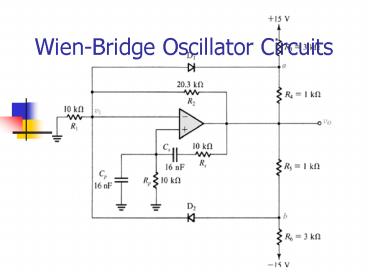Wien-Bridge Oscillator Circuits - PowerPoint PPT Presentation
1 / 20
Title:
Wien-Bridge Oscillator Circuits
Description:
Title: Wein Bridge Oscillators Author: Engineering Department Last modified by: pribeiro Created Date: 4/29/2002 5:46:14 PM Document presentation format – PowerPoint PPT presentation
Number of Views:1332
Avg rating:3.0/5.0
Title: Wien-Bridge Oscillator Circuits
1
Wien-Bridge Oscillator Circuits
2
Why Look At the Wien-Bridge?
- It generates an oscillatory output signal without
having any input source
3
Basics About the Wien-Bridge
- Uses two RC networks connected to the positive
terminal to form a frequency selective feedback
network - Causes Oscillations to Occur
4
Basics About the Wien-Bridge
- Amplifies the signal with the two negative
feedback resistors
5
Modification to Circuit
6
Analysis
- The loop gain can be found by doing a voltage
division
7
Analysis
- The two RC Networks must have equal resistors and
capacitors
8
Analysis
Need to find the Gain over the whole Circuit
Vo/Vs
Solve G equation for V1 and substitute in for
above equ.
9
Analysis
We now have an equation for the overall circuit
gain
Simplifying and substituting jw for s
10
Analysis
If G 3, oscillations occur If G lt 3,
oscillations attenuate If G gt 3, oscillation
amplify
11
G 3
G 2.9
G 3.05
12
Ideal vs. Non-Ideal Op-Amp
- Red is the ideal op-amp.
- Green is the 741 op-amp.
13
Making the Oscillations Steady
- Add a diode network to keep circuit around G 3
- If G 3, diodes are off
14
Making the Oscillations Steady
- When output voltage is positive, D1 turns on and
R9 is switched in parallel causing G to drop
15
Making the Oscillations Steady
- When output voltage is negative, D2 turns on and
R9 is switched in parallel causing G to drop
16
Results of Diode Network
- With the use of diodes, the non-ideal op-amp can
produce steady oscillations.
17
Frequency Analysis
- By changing the resistor and capacitor values in
the positive feedback network, the output
frequency can be changed.
18
Frequency Analysis
Fast Fourier Transform of Simulation
19
Frequency Analysis
- Due to limitations of the op-amp, frequencies
above 1MHz are unachievable.
20
Conclusions
- No Input Signal yet Produces Output Oscillations
- Can Output a Large Range of Frequencies
- With Proper Configuration, Oscillations can go on
indefinitely































